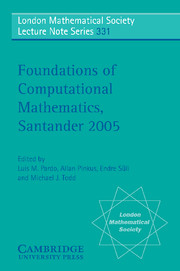Book contents
- Frontmatter
- Contents
- Preface
- 1 Non Universal Polynomial Equation Solving
- 2 Toward Accurate Polynomial Evaluation in Rounded Arithmetic
- 3 Sparse Grids for Higher Dimensional Problems
- 4 Long-time Energy Conservation
- 5 Dispersive Properties of Numerical Schemes for NSE
- 6 Eigenvalues and Nonsmooth Optimization
- 7 Discrete Noether Theorems
- 8 Hyperbolic 3-Manifolds and Their Computational Aspect
- 9 Smoothed Analysis of Algorithms and Heuristics
- 10 High-dimensional Transport-dominated Diffusion Problems
- 11 Greedy Approximations
7 - Discrete Noether Theorems
Published online by Cambridge University Press: 13 May 2010
- Frontmatter
- Contents
- Preface
- 1 Non Universal Polynomial Equation Solving
- 2 Toward Accurate Polynomial Evaluation in Rounded Arithmetic
- 3 Sparse Grids for Higher Dimensional Problems
- 4 Long-time Energy Conservation
- 5 Dispersive Properties of Numerical Schemes for NSE
- 6 Eigenvalues and Nonsmooth Optimization
- 7 Discrete Noether Theorems
- 8 Hyperbolic 3-Manifolds and Their Computational Aspect
- 9 Smoothed Analysis of Algorithms and Heuristics
- 10 High-dimensional Transport-dominated Diffusion Problems
- 11 Greedy Approximations
Summary
Introduction
The question, “Is the long term qualitative behaviour of numerical solutions accurate?” is increasingly being asked. One way of gauging this is to examine the success or otherwise of the numerical code to maintain certain conserved quantities such as energy or potential vorticity. For example, numerical solutions of a conservative system are usually presented together with plots of energy dissipation. But what if the conserved quantity is a less well studied quantity than energy or is not easily measured in the approximate function space? What if there is more than one conserved quantity? Is it possible to construct an integrator that maintains, a priori, several laws at once?
Arguably, the most physically important conserved quantities arise via Noether's theorem; the system has an underlying variational principle and a Lie group symmetry leaves the Lagrangian invariant. A Lie group is a group whose elements depend in a smooth way on real or complex parameters. Energy, momentum and potential vorticity, used to track the development of certain weather fronts, are conserved quantities arising from translation in time and space, and fluid particle relabelling respectively. The Lie groups for all three examples act on the base space which is discretised. It is not obvious how to build their automatic conservation into a discretisation, and expressions for the conserved quantities must be known exactly in order to track them.
- Type
- Chapter
- Information
- Foundations of Computational Mathematics, Santander 2005 , pp. 230 - 254Publisher: Cambridge University PressPrint publication year: 2006
- 4
- Cited by



